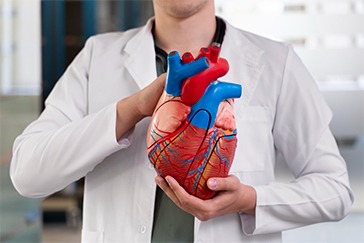 Book Appt.
Book Appt.
 Call Now
Call Now


Understanding Coronary Artery Disease: Causes, Symptoms, Diagnosis, and Treatment
Coronary Artery Disease (CAD) is a prevalent and potentially life-threatening cardiovascular condition that affects millions of people worldwide. SHALBY Sanar International Hospital is committed to providing comprehensive information about CAD to raise awareness and ensure patients receive the best care possible. This article will delve into the causes, symptoms, diagnosis, and treatment options for CAD.
Causes of Coronary Artery Disease
CAD occurs when the coronary arteries, which supply oxygen-rich blood to the heart muscle, become narrowed or blocked. The primary cause of CAD is atherosclerosis, a condition characterized by the accumulation of plaque within these arteries. Plaque consists of cholesterol, fat, calcium, and other substances that gradually build up over time. As plaque accumulates, it can narrow the arteries, reducing blood flow to the heart.
Risk factors for CAD include:
Symptoms of Coronary Artery Disease
CAD often progresses without noticeable symptoms, a condition known as silent CAD. However, when symptoms do occur, they can be severe and life-threatening. Common symptoms include:
Diagnosis of Coronary Artery Disease
Early diagnosis of CAD is crucial for effective management. SHALBY Sanar International Hospital employs a range of diagnostic tools, including:
Treatment Options for Coronary Artery Disease
We offer a range of treatment options tailored to each patient's needs. Treatment may involve lifestyle modifications, medications, or invasive procedures.
Conclusion
Coronary Artery Disease is a serious condition that requires timely diagnosis and treatment. At SHALBY Sanar International Hospital, our dedicated healthcare professionals are committed to providing comprehensive care for CAD patients, ranging from prevention strategies to advanced interventions. By raising awareness and offering the latest treatments, we aim to improve the quality of life for those affected by CAD and reduce its impact on our community. Early detection, lifestyle modifications, and personalized treatment plans are the keys to managing CAD and enjoying a heart-healthy life.
SHALBY Sanar International Hospitals provides extensive medical procedures backed up with our state-of-the-art technology and a team of highly qualified & experienced clinical experts.

Life-Changing TAVR Success Story | Dr. D.K. Jhamb | SHALBY Sanar International Hospitals

Timely Angiography Procedure Saves life of Iraqi Patient.

Rajiv Makhni, Managing Editor of NDTV, Shares His Experience at SHALBY Sanar International Hospitals

A successful treatment procedure helped Ms. Suri get over breathlessness
Our doctors pen down their research findings and experiences from time to time. Their words provide deep insight into the latest techniques, technologies and other advancements in healthcare. It provides expert answers to all kinds of health questions for real-life issues.
VIEW ALL




Since the day of its foundation, SHALBY Sanar International Hospitals is committed to provide comprehensive healthcare services. It regularly organizes awareness programs in its premises and encourages outdoor healthcare activities and camps with an intent to put focus on preventive healthcare.
VIEW ALL